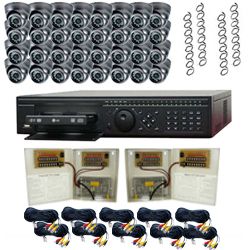 Today’s Digital Video Recorder or DVR security camera systems are an amazing bundle of new high quality technology. The security camera industry can also thank the personal computer industry as a contributor, because a lot of today’s DVR security camera systems use recently invented technology borrowed from the computer industry.
Today’s Digital Video Recorder or DVR security camera systems are an amazing bundle of new high quality technology. The security camera industry can also thank the personal computer industry as a contributor, because a lot of today’s DVR security camera systems use recently invented technology borrowed from the computer industry.
In this article we are going to describe how a typical DVR security camera system works.
Modern digital video security and surveillance systems are basically component systems. This means that essentially, the parts of the system are like plug n play items used in computers. All of the components do not have to be made by one manufacturer, they can differ in function and still work on the system, and they can usually be removed and replaced with something else and the system will continue to work.
This provides tremendous versatility in application because the DVR security camera systems are no longer required to use all of the same components. For example, an 8 channel system may have 6 bullet cameras and 2 Pan-Tilt-Zoom (PTZ) camera made by a totally different manufacturer.
Let’s take a closer look at how a DVR security camera system (and its individual components) works. The first component of the system is the camera. There are so many different type of cameras available today that we do not have the space for this article to cover them all. Instead, let look at how they work
DVR security cameras possess one primary function; transfer the reflecting light that is in its field of vision into electrical impulses that can be measured, manipulated, and compiled to create a digital video file. This information is then sent to the DVR and/or monitor for processing and viewing.
The camera does this by using one of two different electronic sensor chips called a Charged Coupled Device or CCD or a Complementary Metal Oxide Semiconductor or CMOS. Although both sensors work a little differently, the both yield the same end product–the electrical data that can be used to create a digital video file.
This is accomplished by the camera’s lens focusing the field of view onto one of these chips, which generally range from only 1/4″ to 1/2″ square. When the light strikes the sensor chip, small electrical impulses are created by the pixels in the chip. Each one can be measured and used to create the data that will be used to display the cameras field of view as a digital video.
At this point the signal is still an analog type signal. The camera sends this analog data through an analog-to-digital processor chip to convert the data into digital or binary format. The camera also contains a Digital Signal Processor or DSP chip that is used to make fine adjustments to the data. Once the digital information is ready it is sent via a video transmission cable or other means to the DVR, hence the name DVR security camera systems.
Once the signal reaches the DVR, it applies its own DSP technology along with a CODEC utility. Codec is an acronym for COmpression/DECompression. This utility program uses a special algorithm program that reduces the incredibly large file into just a fraction of its original size without sacrificing significant quality. Once this is accomplished the digital video file is compiled and is saved on the DVR’s hard disk drive and/or displayed on a system monitor.
It should be easy to see now why DVR security camera systems benefit from technological improvement in the computer world. Many PC based devices are used in security camera systems. For example, the DVR saves the digital video file to its hard disk drive for storage. USB Thumb drives can be used to update firmware and copy and transfer video footage. DSP and memory chips are directly related to the computer industry.
Even the monitors used today are basically the same as computer monitors but they may include a few extra input options. Monitors have gone from the bulky Cathode Ray Tube (CRT) type to the LCD type just like most computer monitors.
Security Camera King offers a wide selection of DVR security camera systems with everything you need to install it but the tools. Try one of our systems, the Elite Mini Economy, the Elite Mini HD, the Elite Series, or the Ultimate Series and see for yourself. The majority of our cameras come with a 1 year full warranty (some models have 2 years) and our DVRS have a 3 year warranty.











